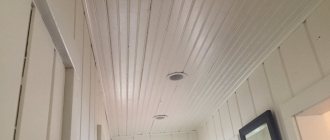Low ceilings are a common problem in many modern apartments, studios and apartments. Height 2.5 meters in typical unusual houses is considered the minimum necessary for a comfortable life and recreation for family members, and it is this that should remain after the completion of repair and finishing work.
A height of more than three meters is more of a luxury; such apartments are not available to many people. If you are going to buy a home, choose options with average ceilings - 2.6 -2.7 m.
However, if you already have an apartment, but want to give it an aesthetically pleasing and beautiful appearance, then you can use some clever tricks. They will help you visually increase the area of the room, giving the rooms an airy and spacious look.
Not all of these photographs show the height of the room below 2.4 meters. But these are the examples that clearly demonstrate how this or that technique works.
No. 3. Setting up the right lighting
Low ceilings in an apartment can be visually raised with the right lighting :
- All natural light must be used to the maximum, so it is impossible to clutter the windows with heavy curtains or, much worse, large pieces of furniture;
- lamps for low ceilings should be compact, minimalistic, and have a minimum height. It is better to replace a large chandelier with a flat tablet chandelier, supplement the lighting with spotlights, spots on a bar, and LED strip. Multi-level lighting will allow you to effectively illuminate all corners of the room, but will not take away the useful height;
- the light from the lamps, reflected in the glossy ceiling, makes the space even more voluminous;
- The direction of the light also matters. Chandeliers, floor lamps, sconces should shine up, not down. It is better to direct the light to the ceiling, creating a play of shadows on it. You should be careful when choosing a lighting source for a PVC stretch ceiling. He is afraid of high temperatures, so it is better to replace incandescent lamps with energy-saving lamps with minimal heat transfer;
- Vertical sconces also work well, providing light both up and down.
No. 6. Architectural Tricks
Color schemes, finishes and visual tricks aren't the only ways to combat the depressing effects of low ceilings. At the stage of repair work, you can pay attention to the architectural component:
- low doorways combined with low ceilings create a kind of mouse hole. Costs increase the height of the doorway, make a spectacular arch, as it will become noticeably easier to breathe in the room;
- you can arrange tall architectural elements such as columns . We want to look at long vertical details, our gaze glides from floor to ceiling, and our brain perceives the height of the room to be somewhat greater than it actually is;
- narrow, high niches have approximately the same effect as columns. If the thickness of the walls allows, you can make several niches in it and paint their surface with a contrasting shade;
- if the room has a fireplace with a characteristic protrusion above it, then this protrusion can be visually highlighted. Designers say this contributes to the expansion of space.
No. 4. Choosing suitable furniture
The right furniture is another touch in organizing the interior of a room with low ceilings. Experts advise taking into account the following tips:
- It’s better to take squat furniture, which will be slightly lower than standard . Flat sofas, low chests of drawers, neat coffee tables will free up more space. A person relaxing on a sofa 5-10 cm lower than usual will be just as comfortable, but the extra centimeters of space above him sometimes turn out to be decisive;
- in living rooms it will be better if the cabinets do not reach the very ceiling;
- in the kitchen it is allowed for the set to be built up to the ceiling, and if its color matches the color of the walls and ceiling, then all sorts of boundaries will be erased. That is why, often when arranging a kitchen in Khrushchev-era buildings, designers maniacally use white color - the result is worth it.
Ideas for a wooden house
Small country houses and cottages often have low ceilings - this is a necessity, since fewer resources are spent on heating. Therefore, the task of visually increasing space is especially relevant here.
Most of the techniques described above are suitable for wooden houses, but a number of other nuances are also taken into account:
- For finishing, use light-colored wood - this will expand the space. Dark shades steal a few centimeters and make the room cramped and uncomfortable.
- Accessories must match the color of the walls. Wooden furniture of the same shade is most appropriate.
- The walls, in turn, are covered with a slightly darker varnish or wax than the ceiling, so that against their background it appears lighter.
- Coffered ceilings are often installed in a wooden house. This is a volumetric finish made of perpendicularly located beams that form cells. The beams are painted a darker color or made lighter in comparison with the base. Due to the contrast, it is possible to visually increase the height of the ceiling.
There are also more radical methods that require certain skills in the construction and repair of such buildings. For example, you can lower the floor. They do this as follows:
- Remove the floor covering.
- Remove old logs. The part may extend into the area of another room, so maximum care is needed.
- The holes formed in the walls are sealed with mortar.
- Cut holes for new logs so that they are lower than the previous ones by a maximum of 25 cm. Install the parts.
- If necessary, insulate the floor. Then the rough coating is laid, then the finishing coating.
Another way is to change the headliner. This option is suitable if the load-bearing beam system is hidden under the finishing material. In this case, the old coating is dismantled and a new one is installed just above the beams. The process consists of the following steps:
- Remove the old finish and dismantle the sheathing.
- Damaged ceiling beams are restored or replaced. The structure is treated with impregnations against fungi, rot and pests. Surfaces are opened with varnish, wax or paint.
- The space between the beams is finished with wooden lining or other decorative materials. First, a layer of thermal insulation is attached to the roof truss structure, on top of which a new ceiling is hemmed.
No. 2. What should the finish be like?
The main nuance in the design of low ceilings is the choice of suitable finishing materials. The right color and texture of the finish is half the battle.
To make the ceiling in a low room visually higher, use these design tricks:
- bet on white. This is a win-win option for all small and low rooms. White color and light, pastel shades can work wonders and literally push the boundaries of space. Painting the ceiling white is the simplest and at the same time very effective solution;
- gloss and shine. We all know how well glossy surfaces reflect light. If the gloss is strong, then it can work like a mirror and literally duplicate the space, so you can’t think of a better solution for a low room than glossy ceilings. You can paint the surface with glossy paint, or install a white glossy stretch ceiling. The last option is used more often than usual by designers and, indeed, works very, very well to increase the height of the room;
- blue shades for the ceiling . Many people call a white ceiling a hospital or office ceiling. If it really causes discomfort, then you can resort to an alternative solution - shades of blue. This color in our subconscious is associated with the sky, so the surface of the ceiling will automatically seem a little higher than it actually is;
- the ceiling should be lighter than the walls. Whatever experiments with colors you decide to do, you must remember that the walls should not be lighter than the ceiling. Otherwise, the ceiling will press even more and seem lower than it is;
- ceiling and walls in the same color . This is a popular design move that allows you to blur the boundary between the surface of the walls and the ceiling;
- box and moldings. If you lay out a box from plasterboard or special polystyrene foam tiles along the edges of the ceiling or make moldings, you can visually deepen the center of the ceiling. It is important that the thickness of such decorative structures is small, otherwise you can get the opposite effect. It is better to decide on such experiments if the ceiling height is 2.5-2.7 m;
- vertical stripes are another win-win way to raise the ceiling. It is better that the stripes are wide and do not combine too contrasting colors. Make only one accent wall striped, otherwise it will make a lot of ripples in your eyes. Instead of ordinary stripes, you can use an ornament of tree trunks or rhombuses. Vertical stripes can be painted on a painted wall, or wallpaper with a suitable pattern can be used. The strips may extend to the ceiling. Natural wood panels also work well;
- ombre effect. This is a bold and fashionable decision. By using a transition from a rich color at the bottom of the wall to light and white at the top, you can achieve the effect of merging the ceiling and walls. The result is a visually higher ceiling.











